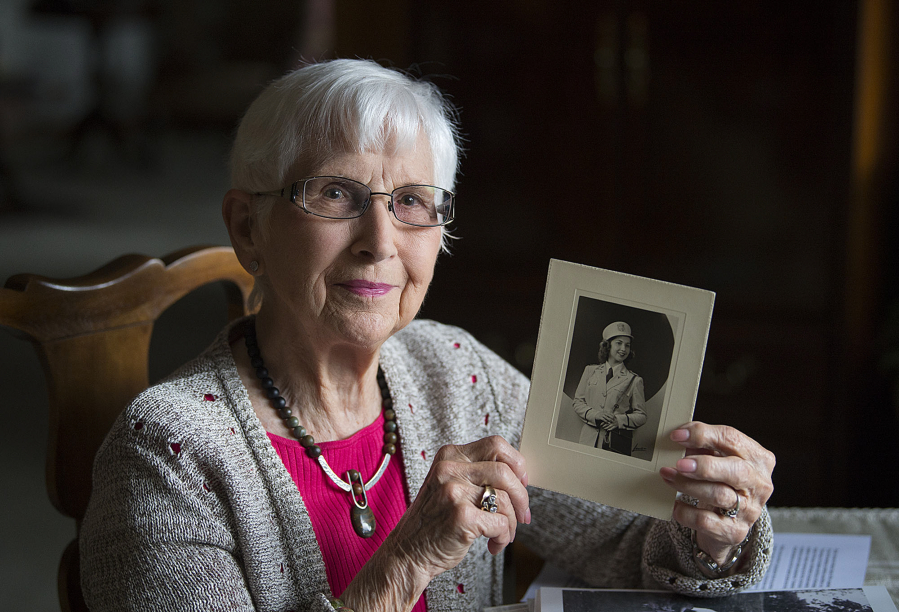Millions of young Americans in uniform 75 years ago would learn about the toll of war in Europe, Asia, Africa and the Pacific.
Elaine Fletcher got her first lesson in Iowa.
As an Army nurse, her service in the Pacific included stops in New Caledonia, the New Hebrides islands, New Guinea and the Philippines.
But her first experience with military patients was in a hospital ward in Clinton, Iowa.
“Fellows back from Guadalcanal. They were being treated for malaria,” she said. “Most of them exhibited even greater psychological need because of their experiences fighting the Japanese.
“The stories of their suffering and its impact are still vivid.”
On a day when the nation remembers those who lost their lives in war, the 97-year-old veteran represents a group that helped reduce the toll. Fletcher was one of 59,000 nurses who served in the Army Nurse Corps during World War II. That marked an impressive growth spurt: There were fewer than 1,000 Army nurses on Dec. 7, 1941, according to www.history.army.mil.
Fletcher volunteered shortly after finishing nursing school.
“At the time, there was a great deal of interest and eagerness to be part of what was happening. Friends were going in,” she said recently in her home near Hockinson. “I had an interest in going overseas; I don’t know why.”
Their introduction to the Army included basic training. It featured long hikes, gas-mask experience, carbine training and crawling on their bellies under barbed wire, with live fire above them.
Pack her helmet
Packing a helmet, bedroll and mess kit, the second lieutenant and her fellow nurses boarded an ocean liner in San Francisco in mid-October and docked in New Caledonia on Nov. 4, 1943.
As American forces advanced across the Pacific theater, the Army kept its nurses away from combat zones. The women worked in hospitals in secure areas, caring for soldiers who had been evacuated from the front lines. But Fletcher’s first post was not exactly an established medical center.
“We were trucked to a jungle area, to a very primitive camp. It was an extremely interesting experience,” she said. Growing up in Dubuque, Iowa, “I don’t think I’d ever camped in my life.”
She was transferred to a hospital on Espiritu Santo, one of the New Hebrides islands. Most of the patients were there to undergo surgery or medical treatment before going back to their units.
“The care was really very good. A good percentage of our patients went back into service,” she said.
The most severe cases — including patients with mental health issues — were transported back to the U.S. mainland. When that hospital closed, the nurses were transferred to field hospitals in New Guinea.
Guessing game
Once they were at a new location, there was a lot of speculation about what might be next.
“We were always wondering, guessing,” she said.
Information about the war was pretty much limited to what they could glean from returning pilots, as well as people back from the front — including their wounded patients — who had limited perspectives.
The nurses had their own role in cutting off information flow, Fletcher added.
“We censored the enlisted men’s mail,” she said. “I don’t recall the personal things. What you’re looking for is information about what’s going on militarily. If you found something questionable, you passed it along to the person in charge.”
Fletcher was in the Philippines when the war ended. But that was just the start of her professional life. After the war, she used her veteran’s benefits to complete college. She eventually earned a master’s degree and had a long career as a public health administrator.
In addition to those veteran’s benefits, Fletcher came back from the Pacific with experiences a young woman would never get in Dubuque.
Some of it involved people she met: “You can’t comprehend the vast difference in cultures,” she said.
Some of it was the natural world: “Swimming in the Pacific with exotic fish. The jungle was fascinating. I’d never seen a bougainvillea in Iowa.”
And even though it was wartime, “I didn’t find myself being fearful.”
Still, “I knew better than to walk around at times without a helmet. You could be hit by a coconut.”




